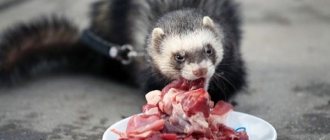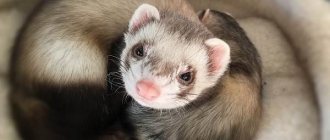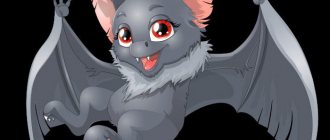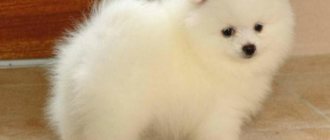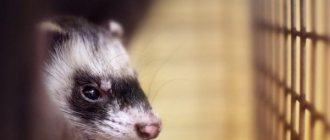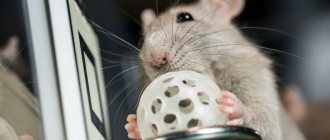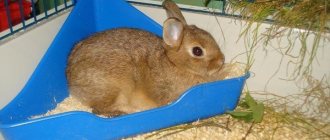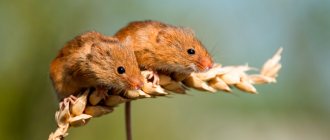- Wild animals
- >>
- Mammals
The ferret , or domestic ferret, is a very active and lively animal, and its behavioral needs are not easily met in a living environment such as our living rooms. However, ferrets are becoming increasingly popular as pets. The ferret is believed to be a subspecies of the ferret and has the same long body as the ferret and weasel.
Origin of the species and description
Photo: Fretka
Ferrets (Mustela putorius furo) are small carnivores belonging to the marten family. The Romans used frets to hunt rabbits. Today they are widely accepted as pets. Handling and manually holding ferrets can be difficult, but most traditional dispensing methods are feasible. The ferret is a domestic animal that is considered native to Europe.
Fun Fact: The name fretka comes from the Latin word "furonem", which means thief, no doubt due to their mischievous nature: ferrets are notorious for stealing light or shiny objects and hiding them.
The ferret is thought to have been domesticated about 2,500 years ago, which is about the same age as other domesticated animals such as donkey and goat. The ferret is used to help farmers track rabbits, and it does this by crawling into rabbit burrows, using its flexible, incredibly shaped body to its advantage as the ferret itself is often smaller than many rabbits. The rabbit is afraid to leave the hole where the ferret has invaded, and uses one of the many other exits from the hole to get away from the intruder ferret.
Video: Fretka
Frets share many anatomical, metabolic and physiological characteristics with humans. They are used as experimental models in studies including cystic fibrosis, respiratory virological diseases such as sudden acute respiratory syndrome and influenza, lung cancer, endocrinology and neurology (especially neurological changes associated with brain and spinal cord injury).
Ferrets' ability to vomit—and their high sensitivity to it—make this species the most widely used animal model in vomiting research, especially for testing potential antiemetic compounds.
Natural enemies

Many of their natural enemies live in the same territory as ferrets, such as:
- Foxes and wolves that are capable of hunting ferrets, especially in winter, when they do not particularly have to choose victims for food.
- Birds of prey, in the form of night owls and golden eagles.
- Wild cats, for whom catching a ferret is not a problem at all.
- Large snakes, although they are not always able to cope with such a mobile animal.
An equally dangerous enemy of the ferret is humans, who cause serious harm to the population of these useful animals, not only exterminating them, but also surviving from their natural habitats.
Interesting fact! To protect itself from natural enemies, the ferret emits an unpleasant odor, which is generated by special glands located at the base of the tail.
As a result of human economic activity, populations of small animals that are part of the diet of these predators are declining, which threatens the existence of ferrets no less than other problems.
Appearance and features
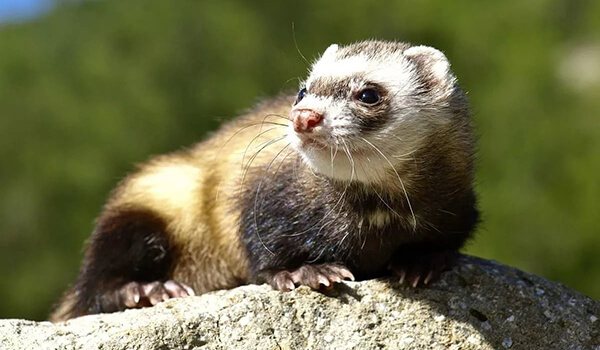
Photo: What a ferret looks like
The ferret is a domesticated form of the European ferret, which it resembles in size and habits and with which it interbreeds. The ferret has yellowish-white (sometimes brown) fur and pinkish-red eyes. She is also slightly smaller than a ferret, averaging 51cm in length, including a 13cm tail. Weighs about 1 kg.
Domestic ferrets reach their adult size at the age of one year. A typical domestic female ferret weighs between 0.3 and 1.1 kg. Domestic ferrets exhibit sexual dimorphism. Males can weigh between 0.9 and 2.7 kg, and neutered males often weigh less than intact males. Domestic ferrets have a long and slender body. Females usually have a length of 33 to 35.5 cm, and males - from 38 to 40.6 cm. The average length of the tail is from 7.6 to 10 cm. Domestic ferrets have large fangs and only 34 teeth. Each paw has a set of five non-retractable claws.
The black-footed ferret is similar in color to the common ferret, but has black eye masks and brownish-black markings on the feet and the tip of the tail. She weighs a kilogram or less, males are slightly larger than females. Body length is 38-50 cm, tail length is 11-15 cm. Domestic ferrets have been bred for a wide variety of fur colors and patterns.
The seven common fur colors are called:
- sable;
- silver;
- black sable;
- albino;
- dark-eyed white;
- cinnamon;
- chocolate.
The most common of these colors is sable. Examples of pattern types are: Siamese or pointed pattern, panda, badger and flame. Besides their choice of specific fur colors, domestic ferrets closely resemble their wild ancestors, the European ferret (Mustela putorius).
Kinds
There are 3 types of frets in total:
1. The black-footed or American ferret is a medium-sized predator; an adult reaches a mass of 910 grams and 40 centimeters in length. At the moment it is an endangered species, since 1967 it has been listed in the Red Book of North America.
In 1937, the American ferret was completely exterminated in Canada, but at the moment the situation associated with the population of the species has improved significantly. Black-footed ferrets live on the prairies, but can often climb mountains. In nature, their diet mainly consists of gophers and prairie dogs. In a year, a ferret of this species can consume about 100 prairie dogs.
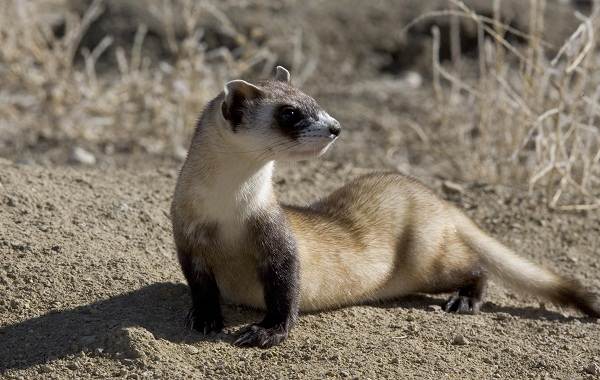
2. Steppe or light ferret - Being the largest representative of its genus, it can weigh up to 2 kilograms, and their body length is 56 centimeters, while the tail grows up to 18 centimeters. Compared to its relatives, it has disproportionately short, but strong limbs, with the help of which it climbs holes well.
The steppe ferret differs from other species in having long hair, but it is quite rare. The guard hair is dark in color, the down is beige, coffee or milky. The ferret's wild relative lives mainly in Western, Eastern and Central Europe. The predator settles in open areas. In the steppe, it hunts for mice, rats and hamsters, which it most often eats. The ferret often feeds on lizards, bird eggs, and fish.
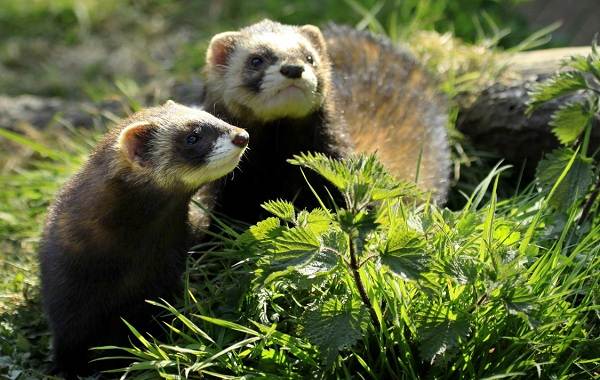
3. The forest or common polecat (dark or black polecat) is a typical representative of the mustelid family, having two domesticated forms: ferret and furo. The ferret has a bright sable color, is very active, curious and cheerful.
In addition, the ferret can be trained at home, and can also master the skills of walking in a litter box and walking on the street in special equipment. Furo is an albino and has red eyes. The forest ferret has an elongated body ranging from 36 to 48 centimeters in length, weighing up to 1.7 kilograms. The basis of the diet of trochees are mice, rats, frogs, toads, bird eggs and large insects.

Where does the ferret live?
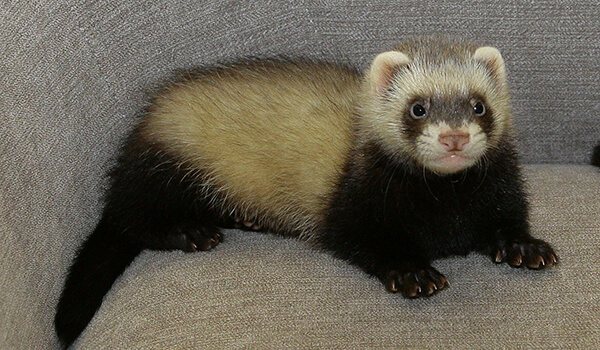
Photo: Homemade ferret
At present, almost no progress has been made in identifying the center of ferret domestication. It is believed that ferrets may have been domesticated from native European ferrets (Mustela putorius). There is evidence of domestic ferrets in Europe more than 2500 years ago. Currently, domestic ferrets are found throughout the world in homes as pets. In Europe, people sometimes use them for hunting.
The habitat of domestic ferrets was forest and semi-forest habitats near water sources. Domestic ferrets are kept as pets or working animals in human living quarters. Black-footed ferrets live in burrows and eat only dogs as prey and carrion. They were originally found living in populations ranging from southern Canada to the American West and northern Mexico. Since agricultural development on the Great Plains was largely eliminated, the ferrets nearly became extinct.
By 1987, the last members of the remaining population of 18 animals were captured from the wild in Wyoming, and a captive breeding program was begun. Of this group, seven females sired young that survived to adulthood. Since 1991, more than 2,300 of their descendants have been reintroduced to local populations in Wyoming, Montana, South Dakota, Kansas, Arizona, New Mexico, Colorado, Utah and Chihuahua, Mexico.
These reintroduction programs, however, have produced mixed results. While Utah, New Mexico, South Dakota and Kansas host self-sustaining populations, the species was classified as extinct in the wild by the International Union for Conservation of Nature (IUCN) between 1996 and 2008. Following a population reassessment in 2008, the IUCN listed the black-footed ferret as an endangered species.
Now you know how to care for your ferret at home. Let's take a look at what you should feed your ferret.
Breeding ferrets
05/30/2019 Beautiful fur and relative ease of cultivation make ferrets one of the most economically attractive fur-bearing animals that can be kept on small backyard fur farms. Fretka
is a domesticated ferret.
More precisely, it is an intraspecific cross the black forest
ferret and
furo
(its albino form).
There are three types of ferrets found in the wild: the light steppe
ferret,
black forest
and
blackfoot
. The first two species are more numerous and quite widespread, and the blackfoot is considered rare; it lives in North America and is now on the verge of extinction.
All ferrets are predators; they belong to the class of mammals, order of Carnivores, family of Mustelidae. In their natural habitat, they exist separately, communicating with each other only during the mating period. Typically, ferrets hunt small rodents, birds, lizards, and eat eggs, insects, and fish. If their nests are located near a person’s home, then they can cause significant damage to the farm by hunting small poultry, stealing chicks or eggs.
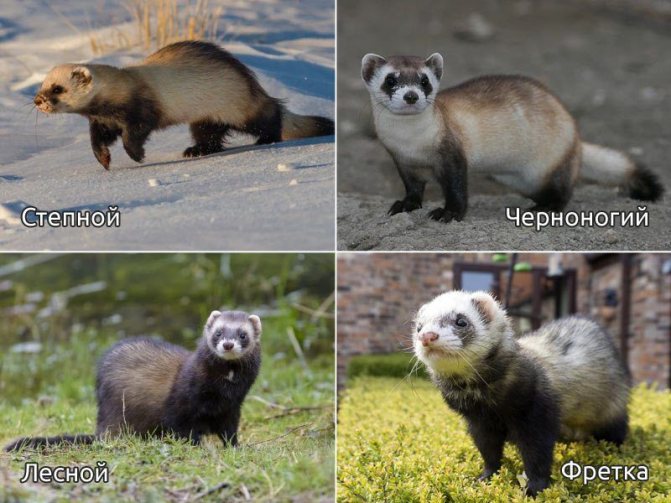
An albino form of the forest ferret, the furo, was tamed and domesticated in southern Europe more than two thousand years ago. Interestingly, the animals were used by peasants to combat rodent pests, performing the same role as cats. A long period of domestication left its mark on their behavior. Furo, unlike the ferret, does not show aggression towards humans, reproduces well in captivity and is strong enough to cope not only with a mouse, but also with larger prey (rats, rabbits, crows).
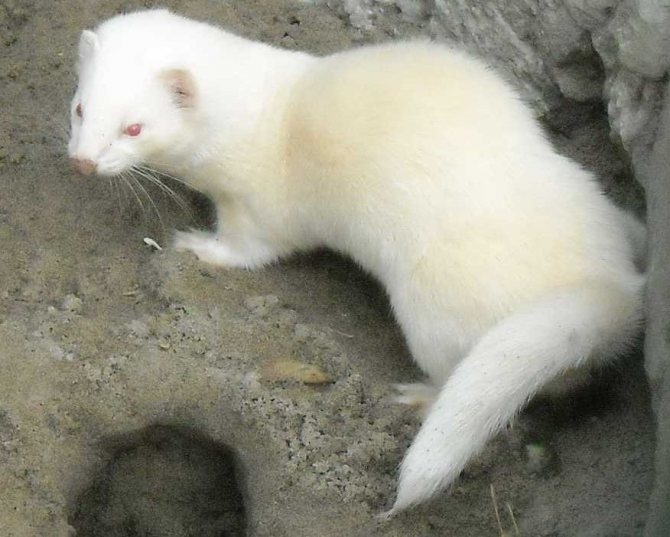
Ferrets obtained as a result of mating a black forest ferret with a furo treat people more kindly, and the quality and color of their fur is much more attractive than that of a black ferret. The fur of ferrets changes its shade depending on the angle of its inspection. A similar effect is created due to the different colors of the guard hairs (black or dark brown) and the undercoat (orange-yellow, white, light gray or light brown). The contrast in the color of the coat and undercoat creates a special play of color in fur products made from animal skins (fur coats, coats, hats, boas, collars, capes, etc.), which is very much valued in fur production.
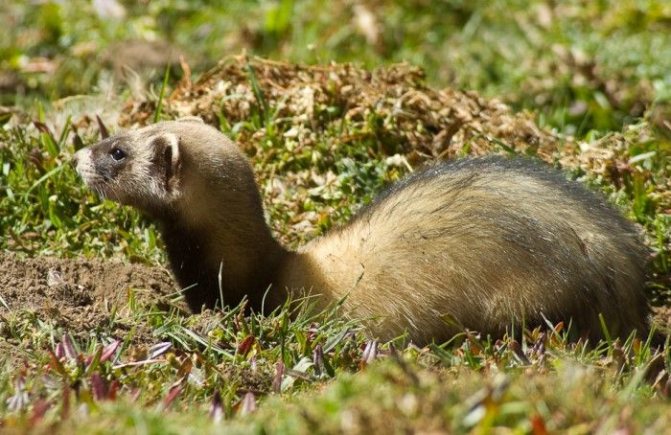
The ferret is a rather large animal: adult males reach a length of 50 cm, while females are somewhat smaller - up to 40 cm. The weight of the animal is about 1.5 - 2 kg. The body of the ferret is elongated, elongated, like that of all mustelids; the paws are short, but very strong, with tenacious claws. The tail is usually fluffy, up to 18 cm long, darker in tone than the main body color.
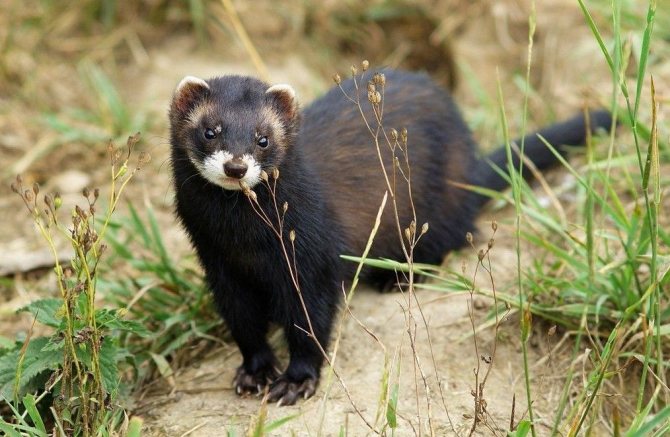
The color of the guard coat is dark, with a lighter undercoat, on the limbs it is almost black or dark brown, on the belly it is light, matching the undercoat. Sometimes dark fur on the animal’s muzzle forms something like a carnival mask, but more often it looks like dark circles around the eyes, which can connect on the bridge of the nose. The lifespan of a ferret at home can be up to 10 years, but it is not kept for that long, since the economic life of the animal does not exceed four years.
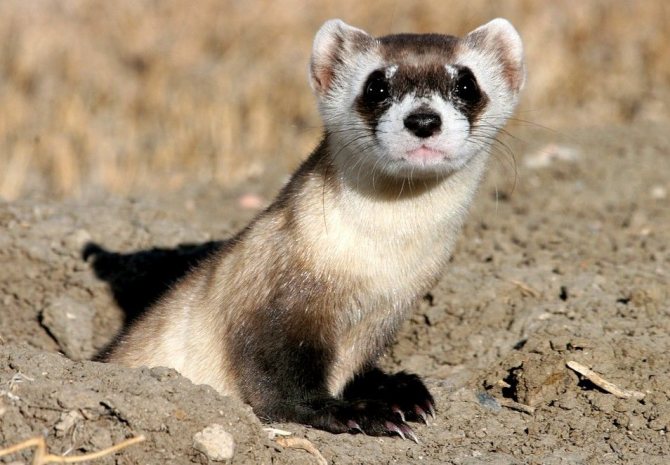
You can keep ferrets in any cages of suitable size or tightly closed enclosures, but if there are a lot of animals, then it is most convenient to do this in sheds
.
A shed
is a frame structure consisting of supports for two rows of cages, covered on top with a common gable roof to protect animals from direct sunlight and precipitation. The side walls of the shad are often completely absent; the ends of the cages face outwards. In bad weather, to protect from the wind, the sides of the shed can be temporarily covered with curtains of PVC fabric, tarpaulin or wooden shields.
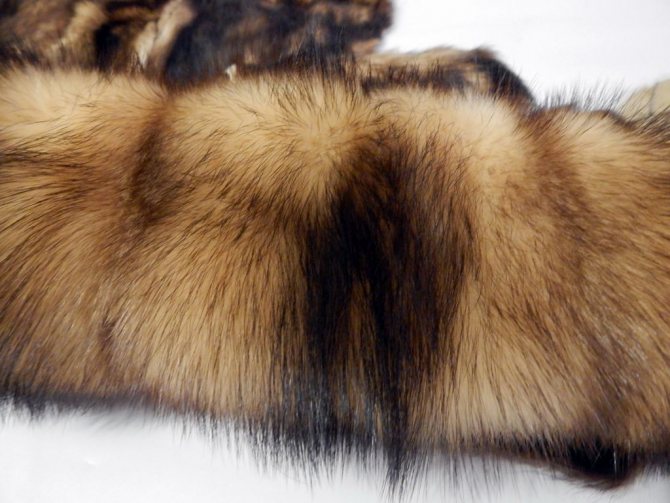
The ends of the shad usually have walls and doors (or gates). Between the rows of cells, a passage (passage) is left along the entire structure. The length of the shad is not limited and is determined only by the needs of the fur farm. Fur-bearing animals, being in such semi-open spaces, have high quality fur and begin the rut (the period when fur-bearing animals mate) at the usual times characteristic of their species.

It is better to keep the parent herd in individual cages, and young animals for fur purposes, subject to abundant feeding, in spacious, group cages. The size of an individual cage for one ferret can be as follows: length 90 cm, height 45 cm, width 45 cm. But if the cage is larger, then it will be good for the animal.
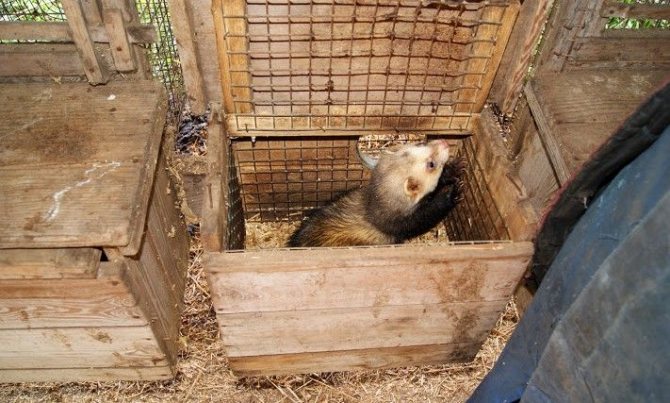
In more spacious cages, the ferry moves more actively, and its fur is preserved in a purer form. A nesting house must be attached to the cage. In nature, wild ferrets live in burrows, and the house is such an imitation, so such housing better suits the physiological needs of the animal.

Feeding ferrets is not difficult, because they are unpretentious in feeding. But the owner should not abuse this. Poor quality or insufficient quantity of feeding cannot but affect the condition of animal fur, the growth rate of young animals and the reproductive abilities of the parent stock.

According to the physiological needs of ferrets, the structure of their diet should be as follows:
— animal protein – 45%;
— fats of animal origin – 25%;
– carbohydrates – 25%;
— fiber – up to 5%.
To compile such a diet, you can use the following foods: meat, meat trimmings, tripe, liver, lungs, ears, lips, bird necks, heads, small fish, blood, cottage cheese, eggs or incubator waste, skim milk, cereal porridges, vegetables, meat and bones , fish meal.
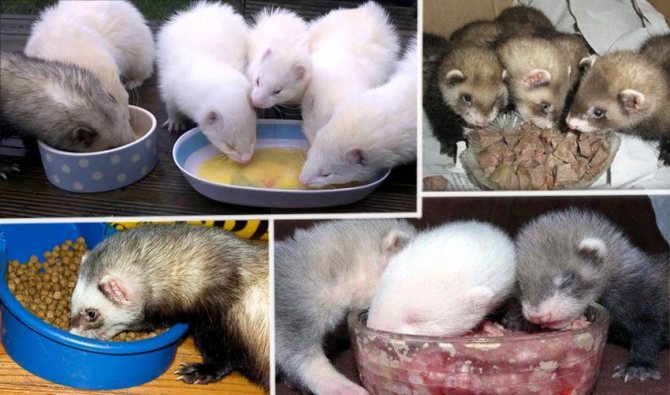
Ferrets eat relatively a lot: one adult animal eats up to 400 g of food per day. An approximate daily diet for him might look like this:
- food of animal origin (meat, meat products, fish, eggs, cottage cheese, etc.) 180 - 200 g;
— animal fat 80 g;
- boiled vegetables 50 g;
- cereal porridge 70 - 100 g.
Feed can be fed in its natural form, or in the form of a crushed homogeneous mixture. Meat and bone meal, fish meal and vitamins are mixed into the ready-made chilled food.
Frets reach sexual maturity at one year of age. Their rut occurs twice a year. During this time, females manage to feed their offspring twice. The first breeding season begins with the onset of warm weather and lasts from the last days of March to the end of April. The second runs from mid-June to early August.
The timing of the onset of the second mating season depends on when the suckling period of the first brood of young animals of this female was completed. If the female was covered for the first time at the end of April, then the female comes to the next hunt at the end of July or in August. But it is undesirable to mate ferrets so late, because late broods grow much worse. By winter, they do not have time to gain weight and become pubescent normally.
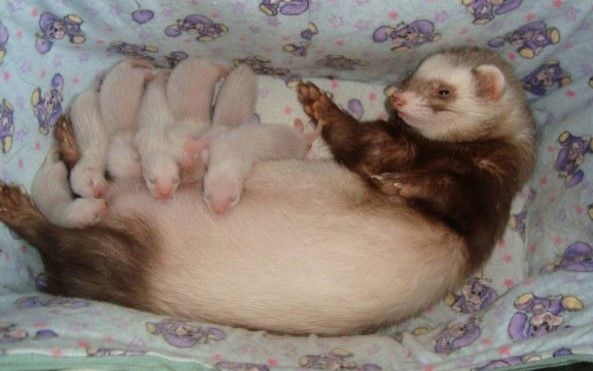
The breeding season is a very important period in the work of a fur farm. Conducting a breeding campaign requires a person to pay great attention to the condition of the animals, experience and appropriate qualifications. In a farm environment, the owner himself monitors the onset of estrus and heat in females based on the condition of her external genitalia and behavior. When heat approaches, the female becomes restless, eats food worse, and her loop turns red and increases in size. All females should be examined every three to five days. When females are detected in heat, they are placed in a cage with a male every day or every other day.
If the female is not yet ready for fertilization, then she behaves aggressively with the male, and the male will not try to cover her. On favorable days (there are from two to five, and they come at the end of the arousal stage), the female allows the male to approach, and he immediately covers her. If mating has taken place, it is repeated the next day to better guarantee pregnancy and increase the number of cubs in the future brood.
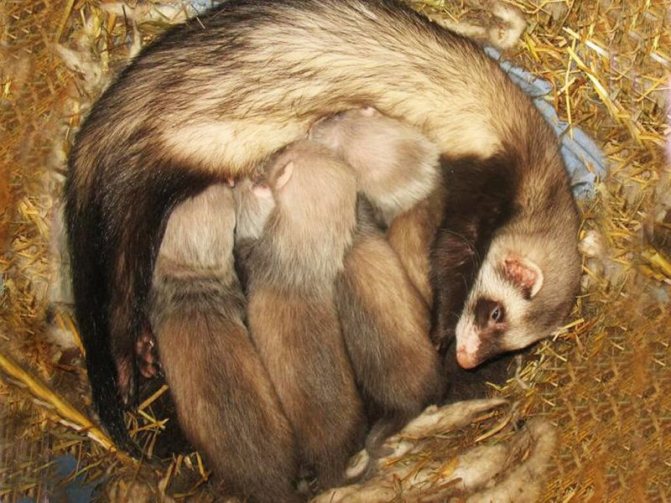
The duration of pregnancy for ferrets is 40 – 43 days. During this period, the owner must create the most favorable living conditions for the female and provide adequate feeding. Otherwise (due to stress, injury, poor feeding and unsatisfactory living conditions), some or all of the embryos may die in the womb.
A pregnant ferret becomes calm, moves less and eats more, and her belly increases. On the 20th day, the animal begins a period of molting and the mammary glands begin to develop. The portion of food for a fertilized female should be increased until her appetite is fully satisfied. The better the female feeds during the period of bearing the cubs, the larger they will be at birth, and the greater the reserve for milk production will be during the period of feeding the brood.
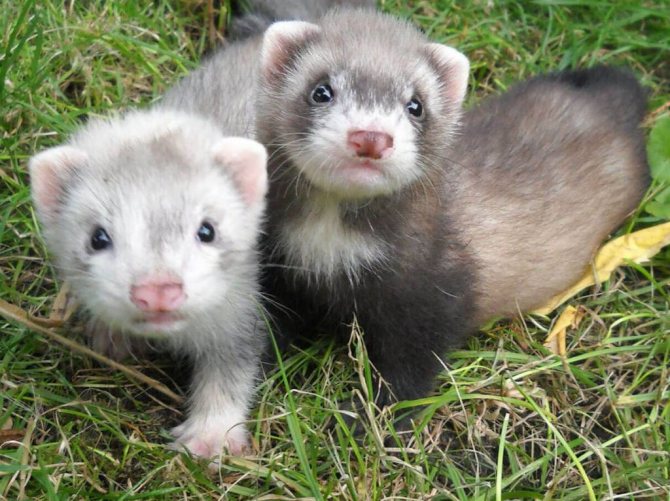
Before giving birth, the female builds a nest from litter and her down in the nesting house. Childbirth, as a rule, takes place without complications, usually about 8 – 10 cubs are born. The first offspring is always more numerous than the second (summer) offspring. The cubs will be born without teeth, blind and deaf, covered with dark short hair, weighing up to 10 g, and no more than 8 cm long.
The milk production of females is very high; the milk produced by a ferret can be enough to feed 12–16 cubs. Normally fed babies sleep most of the time while in the nest. Usually the female has 10 – 12 well-developed nipples. If more cubs are born, then some of them may remain hungry and crawl restlessly around the nest box, complaining for food. In most cases, the female has enough milk for everyone, even if there are fewer teats than the number of animals in the brood. But in young and insufficiently nourished females, the “extra” cubs may become malnourished. Such babies will either have to be artificially fed (and this is a very troublesome task), or distributed among low-fertility females.
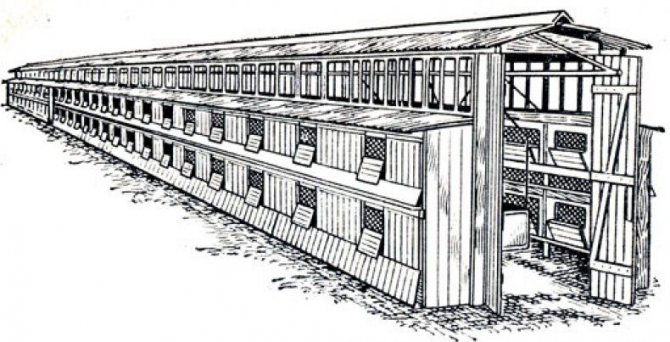
When the cubs are placed in another nest, the female stepmother is distracted with a treat so that she does not see human manipulations in the nesting house. Hands should be washed thoroughly with hot water without soap before work. The “foundlings” are carefully rubbed with down from the receiving nest, after which they are placed in the center of the brood pile and left there for 40–45 minutes. During this time, being in the nest with other cubs, the fosterling acquires the smell of the new nest. After the specified time has passed, the hatch of the nesting house must be opened and the ferret-comilica must be allowed in to the offspring. Furo females accept other people's cubs more easily. You can even add cubs of other mustelid species (mink, sable, etc.) to the furo’s nest.
Young ferrets grow and develop quickly during the suckling period. Babies begin to develop teeth between the 16th and 18th days of life. First, the canines grow, then, on the 22nd - 24th day, the incisors, and after them, at 28 - 30 days, the molars. The auditory canals in cubs open on the 24th - 27th day, the eyes - on the 30th - 32nd day.
Lactation in females lasts up to 30–35 days, after which the amount of milk decreases, and by the fortieth day it stops completely. You can feed young animals with low-fat minced meat from the 20th day. This is especially true if the litter size is large. At the age of 45 - 50 days, the cubs need to be separated from their mother and raised separately.
After laying the cubs, the female comes into heat again a week later and can be fertilized using the same technology as during the spring rutting period. Using this feature of ferrets, you can combine two small broods under one female, and mate the second to produce the next offspring.
It is convenient to raise young ferrets in spacious cages in groups of several animals. When keeping young animals in groups, all conditions should be created to avoid competition for food and territory. To do this, feeding should be plentiful (as much as possible), and the front of the feeder should be such that all animals can approach it at the same time, without creating crowding. With sufficient feeding and good quality feed, young animals quickly gain weight.
The growth rate of the first brood of the year is higher than that of the second. Males grow noticeably faster than females. In a month, the cubs of the first brood weigh 160 g (females) - 180 g (males); the second at the same age - 130 g (females) -140 g (males). At two months, the first weigh 520 - 680 g, the second 400 - 470 g. At three months, the first - from 700 g to 1.2 kg, the second - from 700 g to 960 g. At four months, the weight of cubs from the first litters is from 810 g to 1.3 kg, and from summer broods: 800 g - 1.21 kg. Five-month-old females from the first broods weigh about 860 g, males - 1.6 kg, while females from the second broods weigh about 880 g, and males up to 1.4 kg. At six months, females of early broods weigh up to 950 g with a body length of 37 cm, and males - 1.85 kg with a body length of 44.5 cm. At the same age, females of late broods weigh 900 g with a body length of 35.5 cm, males - 1.5 kg, with a body length of 39.5 cm.
For breeding purposes, it is recommended to select animals only from the first litters.

The timing of fur development in young ferrets also depends on the time of their birth. At one and a half months, all cubs already have pubescence, similar in appearance to the fur of adult animals. Seasonal molting, after which ferrets acquire winter fur, in young animals born in the spring coincides with the molting of adult ferrets - it begins at the end of October, when the cubs of the first broods reach the age of about 4.5 - 5 months, and ends at the end of November or beginning of December , at the age of 6-7 months. At this age, young animals intended for fur production and discarded adult ferrets can be slaughtered.
In young animals that were born as a result of the summer rut, winter fur begins to grow from the end of December and reaches full development in February, when they reach the age of 5 - 5.5 months. In these animals it grows faster than in their relatives from spring broods, but it is not as thick and is valued less.
If you have any questions while reading this material, you can ask them on our forum. Chuguevets Vitaly
What does a ferret eat?
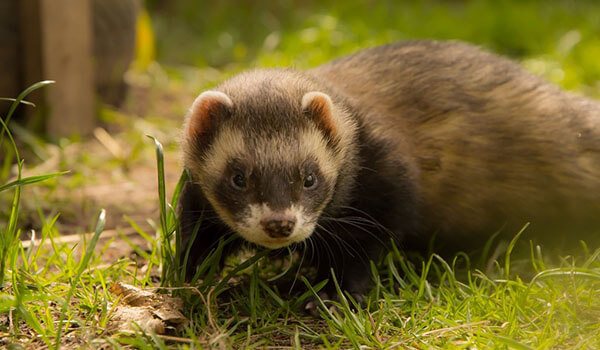
Photo: Ferret ferret
Ferrets are small carnivorous mammals and, therefore, the diet of pet ferrets should consist mainly of meat. In the wild, they mainly hunt mice and small rabbits, and sometimes they may be lucky enough to catch a small bird.
Domestic ferrets are natural carnivores and require a meat-like diet. Food for domestic ferrets must contain taurine, at least 20% fat and 34% animal protein. They can also be fed raw meat, but this alone is not enough. If they were in the wild, they would get nutrients from eating all parts of the animal, such as the liver, heart and other organs. Sometimes pet ferrets are fed supplements (vitamins) to meet nutritional needs that are not met by commercial foods.
Interesting fact: The metabolism of homemade ferret is very high, and food will pass through the digestive tract in 3-5 hours. Therefore, a domestic ferret will need to eat about 10 times a day. House ferrets also have an olfactory imprint. What they are fed during the first 6 months of their life is what they will recognize as food in the future.
The ferret needs a lot of fresh water and a diet high in fat and protein. Many ferret owners give them cat or kitten food, which is largely due to the fact that there is simply very little food available for ferrets. In any case, you'll want to avoid fish and fish-flavored fish food, which can create a litter box odor problem, and don't feed your ferret dog food, as this will fill her up without providing some essential nutrients.
You should also not give your ferret food that people eat, as many foods are toxic or indigestible. Chocolate, caffeine, tobacco products, cola, coffee, tea, ice cream, milk and onions should be avoided. However, ferrets need variety and will do almost anything for fun, including training techniques such as sitting, toe walking, begging and rolling over. You can reward your pet for desired behavior or simply add variety to your ferret's diet with vegetables, fruits and treats.
Habitat

Despite the variety, they are all found throughout the Eurasian continent, North America, and also in northwest Africa. The steppe ferret prefers to live in open areas, and it is almost impossible to find it in crowded places, in forests, in the mountains, etc., but this animal is found in the steppes or semi-deserts of Mongolia, Kazakhstan, China, as well as in some regions of Asia and Europe.
Interesting fact! The fourth variety, bred artificially, cannot be found in the natural environment, since the animal has a fairly peaceful character. In addition, the ferret lacks hunting skills, which does not allow the animal to survive in the wild.
Black ferrets prefer to settle in forests, ravines, near bodies of water, as well as in populated areas, close to people. At the same time, they do not try to go far into the thicket, sticking to open forests, as well as the edges of the forest. The main habitat of the black ferret extends to Europe and part of Africa. The black-footed variety of ferrets prefers forested areas, as well as the prairies of North America, for their livelihoods. At the same time, the black-footed ferret can easily be found in the mountains, at an altitude of more than a thousand meters above sea level.
Features of character and lifestyle
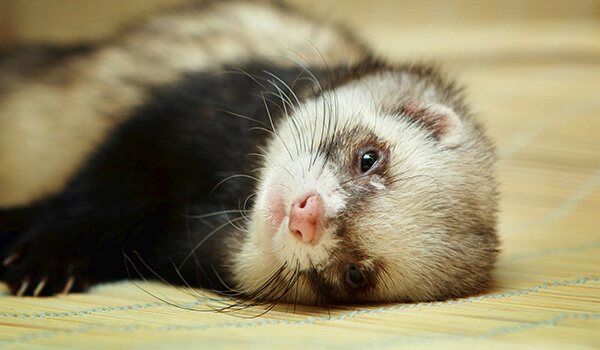
Photo: Fretka at home
Today, the ferret is becoming an increasingly popular pet around the world, thanks to its small size and calm temperament. A number of countries have laws to restrict the use of ferrets to try to prevent them from becoming pests, as ferrets can be quite destructive if released into the wild, especially if they are not native to the country.
Most ferrets spend an average of 18 hours sleeping each day, and they have been noted to sleep for about six hours at a time before waking up to play and eat, and typically return to sleep patterns after about an hour or so Togo. Ferrets are also most active at dusk and dawn, when they are not completely light or dark.
House ferrets are naturally crepuscular, with periods of activity during dawn and dusk. They often change this activity period depending on when their owner is around to give them attention. Domestic ferrets are playful and picky. They often communicate with other beloved ferrets, cats and dogs in a friendly manner. Domestic ferrets will seek attention. They are naturally inquisitive and will tunnel into or under anything. They can be taught tricks and respond to discipline. Pet ferrets have a habit of urinating and defecating in the same places and can therefore be trained to use a litter box.
Ferrets are known for their game of hide and seek, which is especially noticeable in those kept as pets. While it's not known exactly what the ferret will be hiding, owners have reported finding caches of everything from toys to remote controls and keys, and even bags of onions and pizza slices.
Ferrets use different body languages. Some of these behaviors are dancing, fighting, and chasing. They will "dance" when they are happy and excited, jumping in all directions. Fighting is a behavior that involves two or more ferrets. They will roll around with each other, bite and kick, usually in a playful manner. Stalking involves sneaking up on a toy or other animal in a low position.
Ferret: description of the animal
There are several varieties of ferrets, which differ little from each other. It should be noted that each variety has its own characteristics.
Appearance
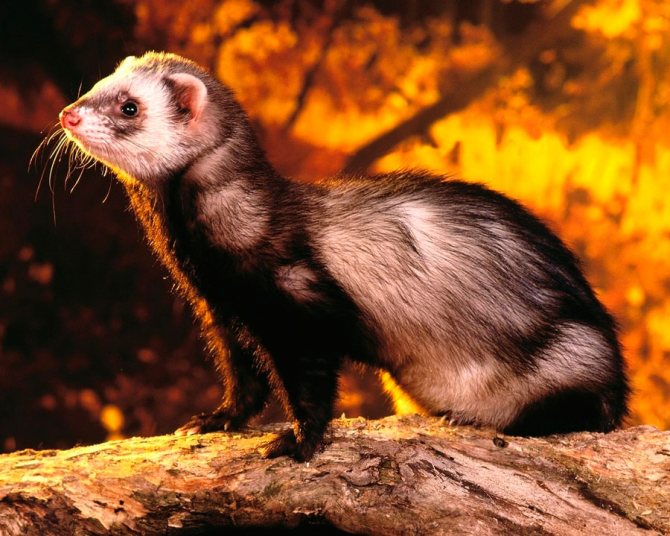
The ferret is a small animal whose appearance is distinguished by its flexibility and grace. Despite the fact that the animal’s legs are quite short, they are muscular and strong. This animal can not only climb trees and dig holes, but is also an excellent swimmer. In addition, the animal has unique mobility, so the animal cannot sit quietly for a single minute.
The color of this small predator can be varied, ranging from light shades to dark, almost black. In this case, the torso is always darker compared to the rest of the body. The coloring of the muzzle is such that the folding pattern looks more like a mask. The animal's fur is relatively long, but fluffy, with the hairs at the base being somewhat lighter than at the ends.
Interesting fact! With the onset of cold weather, at the end of the molting process, the fur of ferrets acquires a special shine and becomes quite beautiful.
Males, although slightly larger than females, reach a length of no more than 60 cm. The peculiarity of these animals is their long and very fluffy tail.
Behavior and lifestyle

Ferrets are nocturnal predators, so their peak activity occurs at night. Moreover, this applies equally to both wild ferrets and domesticated ones. Ferrets lead a sedentary lifestyle, becoming attached to their habitats, and leave their territories only in the event of unforeseen situations, for example, natural disasters.
These animals live in burrows that they dig. They arrange their homes using dry leaves and grass. If they come across an empty hole, for example, a fox hole, then they can easily take it. If necessary, ferrets can easily move closer to humans and inhabit barns or basements.
To find food for themselves, ferrets often appear in villages and villages. After such visits, people are missing poultry. By nature, ferrets are quite active and during waking moments they cannot sit still for even a second. And yet the nature of the behavior depends on the sex of the animal. Females are more cheerful and playful, and their intelligence is noticeably higher than males, so they learn much faster. Males are calmer and more diligent, but they become strongly attached to humans.
How long do ferrets live?

Being in the wild, these animals live a maximum of 3.5 years, since dangers await them everywhere.
Important point! Even a life expectancy of 4 years requires care for the health of the animal, with proper nutrition. If you keep a ferret at home, the animal can live 2 times longer, or even 10 years, although such cases are considered very rare.
Ferret - All about the animal | Domestic Ferret | Fretka
Social structure and reproduction

Photo: Baby ferrets
Male domestic ferrets will mate with as many females as they have access to. Male ferrets have a hooked penis. Once they have penetrated the female, they cannot be separated until the male is free. Males will also bite the back of the female's neck during mating. Homemade frets have a seasonal polyester cycle. Domestic ferrets - males fall into the rut from December to July, females - between March and August. Males are ready to breed when they develop a discolored yellowish undercoat. Increased oil production in the skin glands causes a change in the color of the undercoat.
A female in estrus is defined by a swollen, pink vulva due to increased estrogen. Females may go into lactation in some cases. Lactational estrus occurs when the litter size is less than 5 pups. Lactational estrus is the period when the female returns to estrus as she lactates the litter she just had. Healthy domestic ferrets can have up to three successful litters per year and up to 15 young.
The duration of pregnancy is about 42 days. Young domestic ferrets suffer at birth and require parental care for about 8 weeks. Cubs are born deaf and with their eyes closed. Newborns usually weigh between 6 and 12 grams. Children's incisors appear 10 days after birth. The eyes and ears open when they reach 5 weeks. Weaning occurs at 3-6 weeks of age. At 8 weeks, the cubs have 4 permanent canines and are capable of eating solid food. This is often the time when breeders release their babies to new owners. Females reach sexual maturity at the age of 6 months.
Reproduction and lifespan
Regardless of the species, the breeding season for ferrets is year-round, but by spring their genitals enlarge. Clear signs of preparation for mating are visible for about one month. In trochee puppies, puberty begins at 6 months. Females should be bred upon reaching 10 months, when the genitals are sufficiently developed.
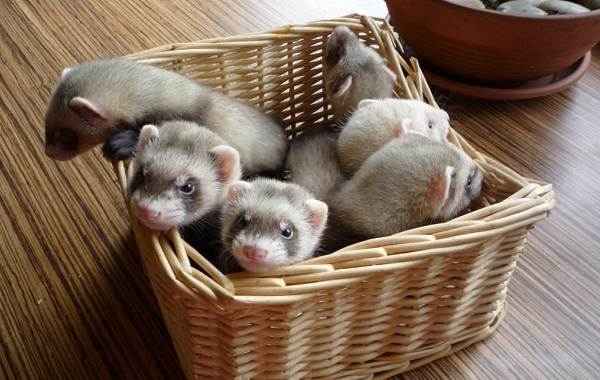
Mating can be done 2-3 weeks after the female’s loop swells. If mating occurs earlier, then only up to 4 puppies are born. If mating is timely, the litter will be much larger - up to 12 babies. If mating occurs later, there will be no offspring.
Pregnancy lasts about 40-45 days. If the birth is successful, the female gives birth to deaf, blind and toothless puppies. The cubs open their eyes after 1 month. On average, horis give birth to offspring up to 2 times a year. Indoor ferrets can go for walks up to 4 times a year. The ferret may not go on a spree if you do not monitor the animal’s diet.
By the age of one month, a ferret weighs about 150 grams. Domestic animals are usually acquired at this age, since they can easily survive without a mother. Already at 6 months, the ferret practically stops growing, and the need for large amounts of food can sharply decrease.
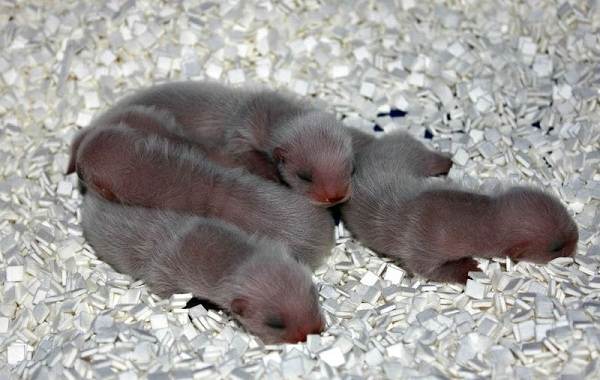
If you feed your pet well, it can outgrow its wild counterparts. However, even here you need to know when to stop. Males can develop limb disease from overfeeding, so young ferrets should be given more active exercise. All lovers sooner or later are interested in the question: how long do ferrets live? On average, their life expectancy is 10 years.
Natural enemies of ferrets
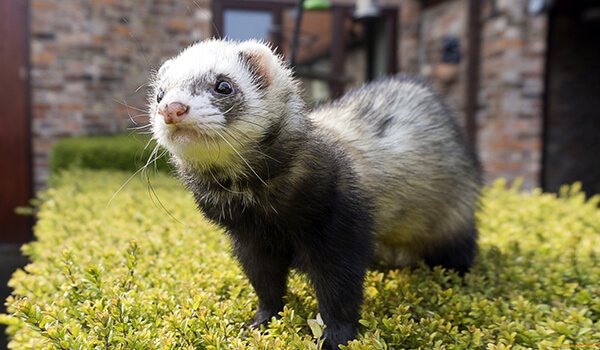
Photo: What a ferret looks like
Ferrets are preyed upon by golden eagles and great horned owls, as well as other carnivores such as coyotes and badgers. Poisons used to control them, especially sodium monofluoroacetate and strychnine, likely contribute to deaths when ferrets eat poisoned animals. Additionally, black-footed ferrets are extremely susceptible to many infectious diseases such as canine distemper. Bubonic plague may severely reduce prairie dog populations and thus cause food shortages for black-footed ferrets, but it is unknown whether ferrets themselves become infected with the plague.
Domestic ferrets have no natural predators because they are domesticated. Predators such as hawks, owls or larger carnivorous mammals would hunt them if they had the chance. On the other hand, pet ferrets can be predators of certain animals. They were known to kill poultry. Domestic ferrets will also hunt rabbits and other small game when used for breeding by their owners. There are also records of ferrets being used to control rodent populations on ships during the American Revolutionary War.
Domestic ferrets are not able to survive for long in the wild. As pets, they can live 6-10 years. There are several diseases and disorders that can shorten the lifespan of pet ferrets if left untreated.
Some of these diseases and disorders include:
- canine distemper;
- feline distemper;
- rabies;
- parasites;
- bone marrow suppression;
- insulinoma;
- adrenal gland diseases;
- diarrhea;
- cold;
- flu;
- ringworm;
- heatstroke;
- urinary stones;
- cardiomyopathy.
Is it worth bringing home an animal?
For those who are not familiar with the pet ferret, it is important to educate yourself about its characteristics beforehand. This is necessary so that you don’t have to cancel the purchase later. Then it will be offensive not only to the owner, but also to the animal.

Of course, a dog or cat requires no less attention in care. But such favorites have become familiar in every family. With ferrets the situation is different. They made friends with people quite recently. Therefore, consider the main disadvantages of animals, namely:
First of all, a ferret’s daily routine comes as a surprise to many. Those who have children are especially disappointed. After all, kids want to play with pets around the clock.
With such a pet this trick will work. This is because a ferret spends most of her life sleeping. She sleeps soundly and for a long time. In this case, waking her up is extremely harmful and undesirable. This will ruin your pet's health.

Secondly, ferrets do not have the ability to wash themselves like cats. In general, they are not particularly clean. On top of that, the animals emit an unpleasant odor. By the way, the “aroma” intensifies if the ferret is sick or scared.

Therefore, it is important to initially warn your family about this feature of your pet. But in such “incidents” nature is to blame, not the animal. After all, in the wild they use unique pheromones to scare away enemies.
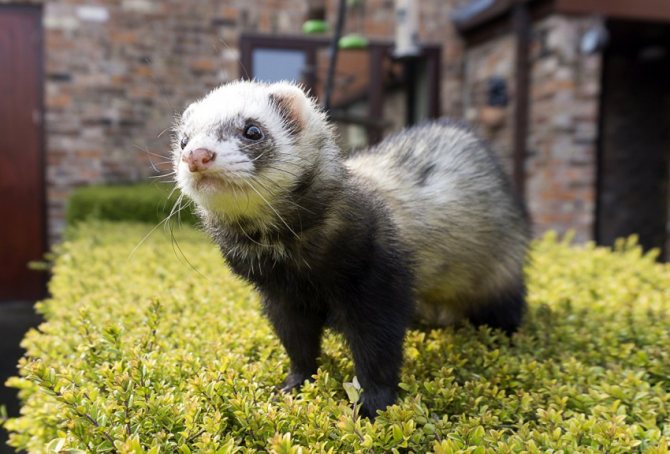
Note!
- How to protect a gazebo from rain and wind in summer and snow in winter - a review of the best options

Chicken - description, types, classification, nutrition and maintenance of domestic chicken (115 photos and videos)
- Sheep - lifestyle, description of breeds, habitat, feeding and care of sheep when growing (145 photos and videos)
Thirdly: such an animal requires constant supervision. After all, ferrets do not understand commands and cannot be trained. But they are interested in all small-sized objects in the house. Therefore, any little thing should be hidden from the sensitive eye of the animal.

In general, despite the obvious nuances, ferrets are very peaceful. They adore children if they treat them well. If mistreated, you can expect aggression and refusal to eat.
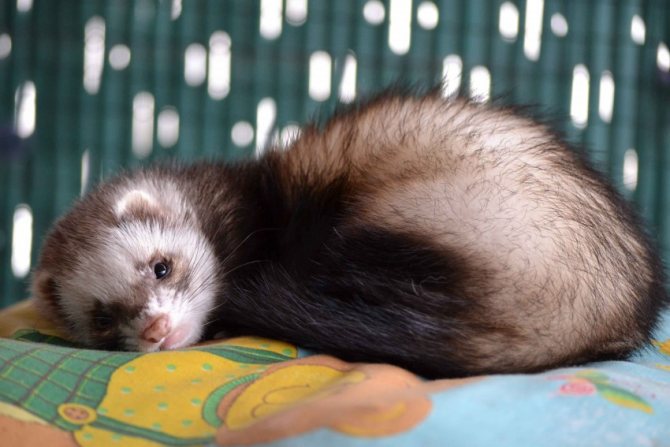
By the way, you can find out how much a ferret costs in nurseries or pet stores. But they must have a license. All conditions for these gentle animals to live are provided there.
Lifestyle and behavior
By nature, the ferret is aggressive and fearless; it can rush at an animal that is larger than it in size if it senses danger. The animal sleeps during the day and rarely leaves its shelter during daylight hours. At night the predator goes out hunting. He watches for the prey at the entrance to the dwelling or rushes after it, sometimes even catching prey on the move. The ferret is a good swimmer, so you can find it near small rivers or other bodies of water.
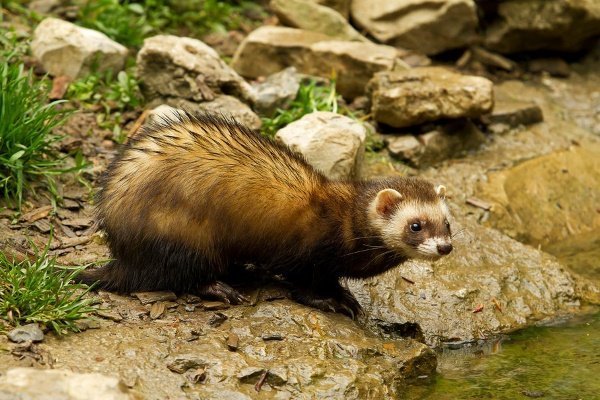
Eating in the wild
Although the wood ferret is relatively large in size, it is a typical mouse eater. The main diet of the animal consists of:
- small rodents - mice, rats, gerbils, voles, moles, gophers and ground squirrels;
- frogs and toads;
- large insects such as locusts;
- hares and rabbits, can penetrate animal burrows and strangle young individuals;
- reptiles - lizards and snakes;
- small birds and their chicks, as well as eggs from ground clutches;
- invertebrates such as worms;
- carrion - if there is no other source of food, then the ferret will not disdain carrion.
One interesting feature of the forest ferret is noted - when attacking a bird's nest or getting into a hare's hole, the animal completely ruins them and strangles all the individuals located there. Although he only eats a small part.
Features of ferret care
In order for the ferret to feel comfortable, it is necessary to take into account all the subtleties in the care and maintenance of the animal at home.
To ensure a healthy existence for an animal, you should take care of its cleanliness, so you need to regularly clean the cage and wash out all its contents: drinking bowl, feeders, tray, and change the bedding.
As for bathing the ferret, it should not be too frequent, since this process can provoke an increase in the specific smell of the pet. In addition, if your pet does not really like water procedures, then bathing 2 times a year will be quite enough.
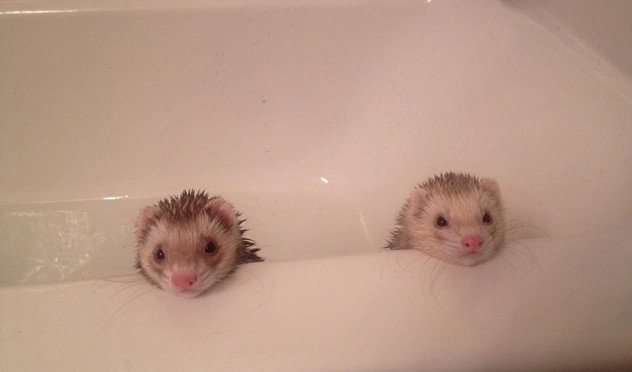
For bathing, you should purchase special shampoos that have a pleasant aroma and are absolutely safe for the animal. The procedure can be carried out both in a container and simply under the shower. After bathing, the animal is thoroughly dried with a towel.
In stores you can purchase special wipes or sprays that are used to treat fur to make it look clean, shiny and have a pleasant smell.
Particular attention should be paid to trimming the ferret's claws. The procedure is performed at least once a month. To trim the claws without harm to yourself and the animal, you will need an assistant who will hold the animal tightly while you perform the manipulation.
The ears should be cleaned every month; for this purpose, special drops are sold that are inserted into the ear. The ears are lightly massaged and then cleaned using cotton swabs.
Due to the fact that in the spring and autumn periods ferrets begin to shed, in order to facilitate the procedure, it is recommended for the animal to comb out its fur using a special brush. Shedding lasts for 2 weeks, so it is worth brushing every day, perhaps even twice a day.
Character of ferrets
The ferret looks very cute. But despite its appearance and small size, it is a predatory animal.
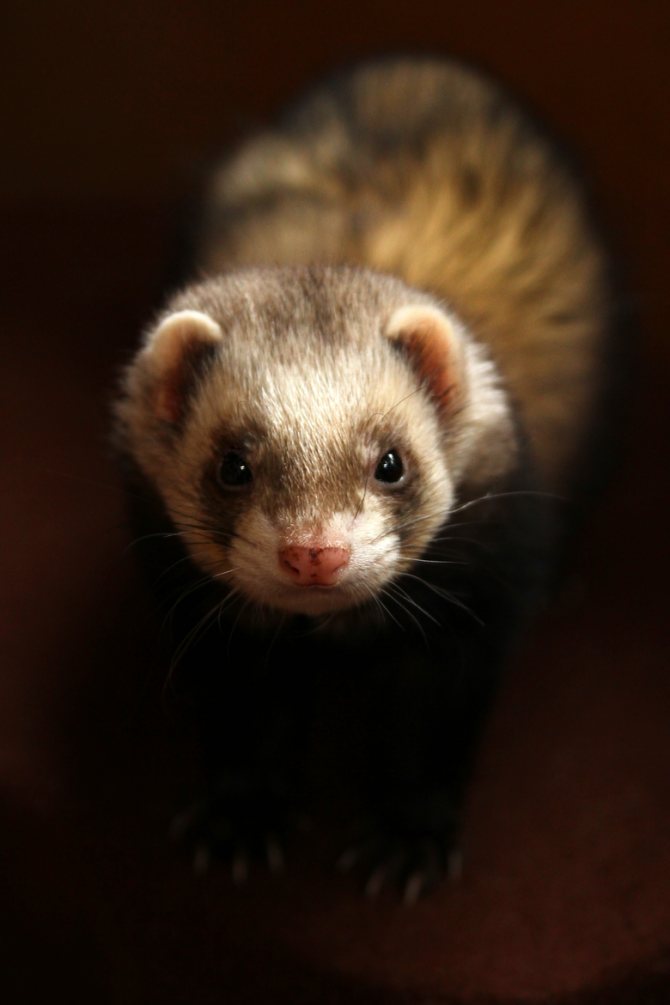
But these mammals, of course, do not like excessive attention to themselves. Therefore, most often wild ferrets live in burrows.

The largest weight can reach two kilograms, and the smallest about 200 grams.

If you look at a photo of a ferret, you will see its long and bushy tail. It can grow up to 20 centimeters in length. These mammals are covered with fur, usually dark at the ends but light at the roots.

There are, however, albino ferrets, and there are also completely black ferrets.
What does a wood ferret look like?
The ferret is small in size and in appearance is a typical representative of its family.
Constitution
The body is elongated, flexible, squat with short but strong legs. This structure allows it to silently sneak up on its prey. The ferret has an elongated neck, a small oval head, an elongated muzzle, slightly flattened towards the nose.
Basic parameters of the forest ferret:
| Body length | Weight | Tail length |
| 29-46 cm | 650-1500 g | 8-17 cm |
Color
The animals have long fur, which can reach 6 cm, and different colors - from dark gray to black. However, in the wild there are also individuals with brown, reddish, yellow colors, and there are also albino representatives.
Color is never monotonous. Thus, the tail, belly and paws are always darker than the body, and on the muzzle there is a white mask, which is a characteristic feature of a ferret.
In winter, after molting, the color of the forest ferret becomes darker than in the warm season.
Structural features
The main structural features of the animal include:
- the small head smoothly transitions into a flexible and elongated neck;
- the ears are small, low, with a wide base;
- the eyes are brown, shiny, bead-like;
- the paws are short and thick, even in the largest individuals the length of the hind legs is only 6-8 cm;
- the paws have 5 toes, between which there are membranes;
- the forest ferret has 28-30 teeth, of which 4 canines, 12 premolars, 12-14 incisors;
- next to the tail of the animal there are special glands, which, in case of danger, secrete a secretion with a fetid odor.
Is it possible to propagate at home?
Breeding ferrets at home is quite simple; to do this, you just need to take into account all the nuances of breeding:
- the female must be 11 months old and the male 8 months old;
- in order to perform mating, it is necessary to place the female with the male, repeat the process 3 times;
- individuals must have all the necessary vaccinations;
- Before the offspring are born, the female must be moved to an empty cage.
At one time, the female can breed up to 10 individuals, which remain with the mother in the cage until the age of 4 months.
Important! It is worth remembering that healthy offspring will be born only if the parents were healthy and did not have any problems, were regularly vaccinated, and the age of the animals at the time of mating was observed.
Nutrition
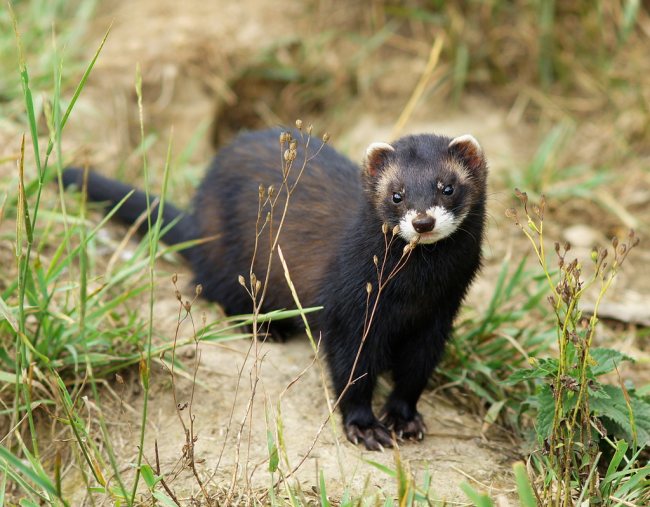
Despite its funny and cute appearance, the ferret is a formidable predator.
What do these cute creatures eat? In order for your pet to feel great, healthy and full of energy, it is necessary to take into account the following nuances and features of feeding:
- Due to the fact that in natural conditions such a pet prefers to hunt small rodents, it is quite possible to offer it mice and rat pups as food. It is not difficult to imagine what such feeding looks like, so this measure is not an extreme necessity.
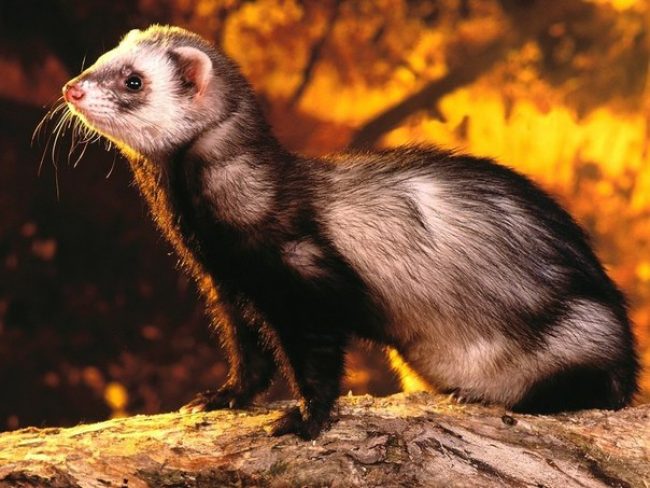
Ferrets' favorite treat is various rodents.
- A sleeping little predator worries about the future in advance, hiding its supply of food in a secluded place. In order to prevent this, it is necessary to calculate the serving size, guided by the individual needs of the animal.
- You should not feed your pet food containing large amounts of “fast” carbohydrates. Such a diet can cause significant harm to him.
- From time to time it is necessary to include in the diet such foods as raw or boiled eggs, cheese, cottage cheese. However, this should be done no more than three times during the week.
- A sleeping animal also spends energy in its sleep, so it should be fed at least twice during the day, with the second feeding occurring shortly before the period of prolonged sleep.
